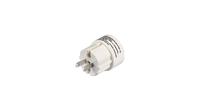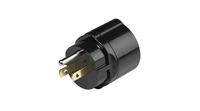Fun fact or warning.
European to American standard plug adapter with grounding.
Bearing in mind the imminent arrival of the family to me, I looked around Polish stores a bit to find a suitable plug adapter for them.
The equipment they bring with them can run at 110VAC. One of these devices requires an earth connection.
During my search, I came across a MediaMarkt store that offered the miracle shown below;

Someone probably did not realize that the American 110VAC sockets have no pins.
The US plug for 110VAC with ground looks like the picture below.

To be quite annoying, I will mention that this is a 110VAC 15A plug. 110VAC 20A plugs / sockets are still available.





